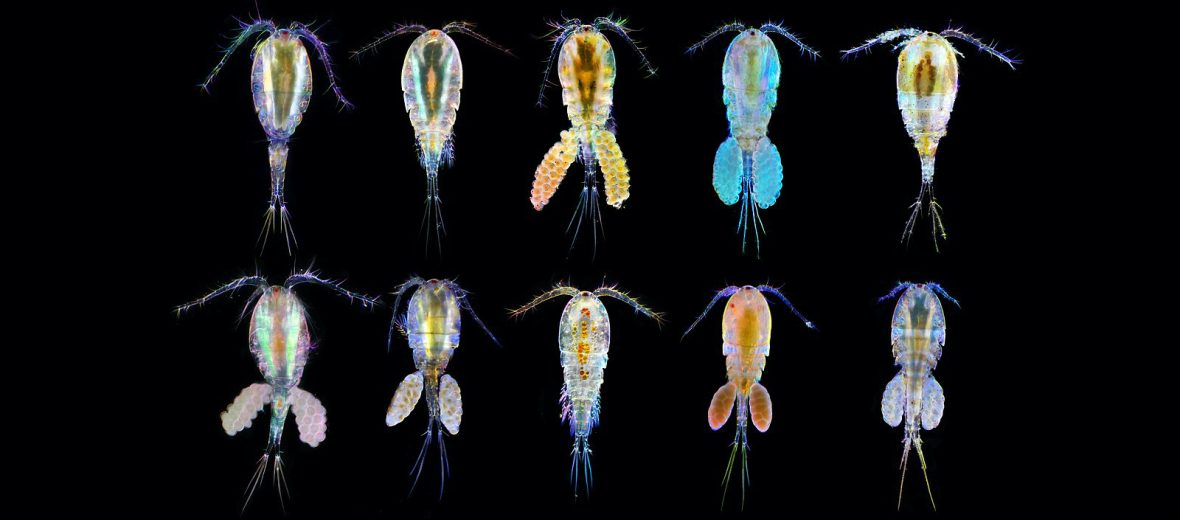
Copepods are a group of small crustaceans found in practically every freshwater and saltwater habitat in the world, including Antarctica. Some species are planktonic, while others are benthic (live on the ocean floor). While still more thrive in damp or wet soil. Due to their abundance, these critters are not evaluated by the IUCN.
First the Stats…
Scientific name: Copepoda
Length: Up to .5 inch
Lifespan: Up to 1 year
Now on to the Facts!
1.) Some copepod species go through parasitic phases.
2.) There are species that live in limnoterrestrial (experiencing periods of immersion and desiccation) habitats and various other wet terrestrial places, such as swamps, under leaf litter in wet and damp forests, puddles, damp moss, bogs, springs, ephemeral ponds, or water-filled recesses of plants like pitcher plants and bromeliads.
3.) Copepods are often utilized as biodiversity indicators that provide us with information as to how humans are impacting various habitats.
4.) Nearly all copepods have a single median compound eye, that is typically bright red and located in the center of their transparent head.
5.) Some subterranean species lack eyes altogether.
But wait, there’s more on the copepod!
6.) Members of the genera Corycaeus and Copilia have 2 eyes.
7.) Some possess a very fast jumping response when a predator is detected. Others, that are water-based, have a quick propulsion method to escape death.
Did you know…?
Because these critters are so small, most have no need for a heart or a circulatory system.
8.) Eggs hatch into a nauplius form, with a head and a tail but no true abdomen or thorax.
9.) The larva will typically molt several times until it looks similar to the adult and then, after even more molts, they achieve their final adult form.
10.) 1 method of locating food is via chemical detection of sinking debris, known as marine snow.
But wait, there’s still more on the copepod!
11.) Most free-living copepods feed exclusively on phytoplankton, by catching the cells individually. Just 1 copepod can consume up to 373,000 phytoplankton per day!
12.) They typically have to process the equivalent of up to 1,000,000 times their own body volume of water, each day, to meet their food needs.
Did you know…?
3 of the 10 known orders of copepods are predominantly parasitic.
13.) Cannibalism often occurs, as larger copepods tend to feed on smaller copepods.
14.) Benthic copepods tend to eat organic detritus or the bacteria that grows in it, and thus their mouth parts have evolved for biting and scraping.
15.) Numerous copepods, like the Siphonostomatoida, are parasitic and feed on the tissue or the eaten food of various aquatic creatures.
But wait, there’s still a little more on the copepod!
16.) During mating, the male copepod will grip the female with his first pair of antennae, which is sometimes modified for the purpose of mating. The male then produces an adhesive package of sperm and transfers that to the female’s genital opening with his thoracic limbs.
17.) Sometimes eggs are laid directly into the water column. Other times the eggs are encased in a special sac and attached directly to the female, till they hatch.
Did you know…?
Some scientists believe that copepods form the largest biomass on earth. This title is often shared with Arctic krill.
18.) Some pond-based copepods create eggs that are enclosed in a tough shell that can lay dormant for extended periods of time, in cases where the pond or swamp dries out.
19.) Eggs hatch in up to 19 days, based on the species.
20.) Planktonic copepods are incredibly important to the global ecology and to the carbon cycle. They are the primary food organisms for smaller fish and crustaceans.
But wait, there’s still just a tad more on the copepod!
21.) Of the 14,000 described species of copepods, nearly half are considered parasitic.
22.) Not only are these critters sometimes parasitic, but they too are subject to being parasitized. The most common parasites are marine dinoflagellates from the genus Blastodinium. These are abdominal parasites of many copepod species.
23.) Fossil records show these critters as being around since at least 303 million years ago, from the late Carboniferous period.
24.) Live copepods are often utilized in the saltwater aquarium hobby as food for certain inhabitants and are typically considered beneficial in many reef tanks. They are scavengers and also tend to feed on algae, including the calcified coralline algae. I have personally used them in my reef aquariums, in the past.
Did you know…?
Copepods have been used successfully in Vietnam to control disease-bearing mosquitoes like the Aedes aegypti that transmit such lethal illnesses as dengue fever and other human parasitic diseases. The copepods attack, kill, and eat the younger first and second instar larvae of mosquitoes.
25.) Copepods are sometimes even found in public main water supplies, particularly in systems where the water is not mechanically filtered, as is the case with Boston, New York City, and San Francisco. But this usually isn’t a problem within treated water supplies.
But wait, there’s a smidgen more on the copepod!
26.) In some tropical countries, like Bangladesh & Peru, a correlation has been discovered between copepods’ presence and cholera within untreated water. This is due to the cholera bacteria attaching to the surfaces of planktonic animals. The larvae of the guinea worm needs to develop within a copepod’s digestive tract before being transmitted to humans.
27.) The character in the cartoon series about a certain happy-go-lucky sponge features a copepod named Sheldon.
Now a Short Copepod Video!
Be sure to share & comment below! Also, check out the Critter Science YouTube channel. Videos added regularly!
Want to suggest a critter for me to write about? Let me know here.
Photo credit: Andrei Savitsky



